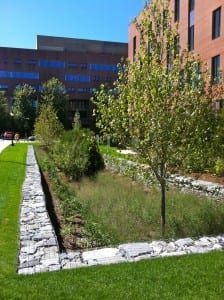
Although UConn is in the midst of a pastoral setting in the quiet corner of northeast Connecticut, we sometimes have problems like a big city. This is because the buildings, roads, parking lots and sidewalks that make up the core of campus do not allow water to pass through into the ground. Instead, rainfall is directed into storm drains, and ends up heading towards either the Fenton River to the east, or Eagleville Brook to the west. All of the excess stormwater and pollutants that get picked up along the way cause problems with the aquatic life in these rivers. The CT Department of Energy and Environmental Protection has identified Eagleville Brook as impaired. UConn Extension’s Center for Land Use Education and Research (CLEAR) has been involved in efforts to reduce the impacts of all of these impervious surfaces on Eagleville Brook. Green infrastructure practices like bioretention, green roofs, and pervious pavements have been installed around campus to help restore a more “natural” hydrologic balance. A Total Maximum Daily Load (TMDL) has been established for the brook, with impervious cover as the “pollutant” (read more about this project at http://clear.uconn.edu/projects/tmdl). An interactive map tour with photos and videos is available online here.
With all of the changes taking place on campus, keeping track of the actual impacts of the green infrastructure implementation is not an easy task. Traditional water monitoring could be done, but this is very expensive and time consuming. Recently, UConn Extension Educator Michael Dietz at CLEAR created a unique system to estimate the benefits of the green infrastructure on campus. This tracking system uses real precipitation data from UConn, and estimates the amount of stormwater treated by each practice installed, given how big the practice is, when it was installed, and the condition of the practice. This allows for a running total of the volume of stormwater treated. Through June 2014, more than 42 MILLION gallons of stormwater have been treated! To put this in perspective, this is enough to fill more than 63 Olympic sized swimming pools!
This information is being used to track progress on the TMDL, along with other regulatory obligations between UConn and DEEP. Dietz plans to continue this tracking, along with other monitoring he and Jack Clausen perform on Eagleville Brook (real-time data available here).